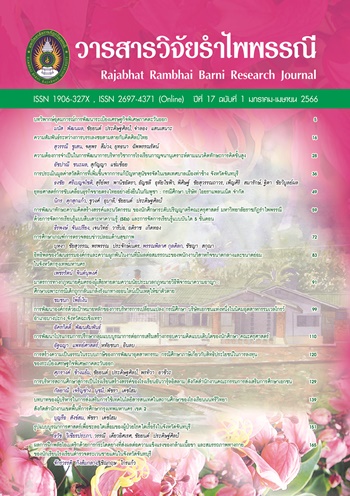อิทธิพลของวัฒนธรรมองค์กรและความผูกพันในงานที่มีผลต่อสมรรถนะ ของพนักงานวิสาหกิจขนาดกลางและขนาดย่อม ในจังหวัดกรุงเทพมหานคร
Main Article Content
บทคัดย่อ
งานวิจัยครั้งนี้มีวัตถุประสงค์เพื่อศึกษา 1) ปัจจัยด้านวัฒนธรรมองค์กร ความผูกพันในงาน และสมรรถนะของพนักงาน 2) แนวคิดและทฤษฎีด้านวัฒนธรรมองค์กร ความผูกพันในงาน และสมรรถนะของพนักงาน และ 3) ปัจจัยด้านวัฒนธรรมองค์กรและความผูกพันในงานที่มีผลต่อสมรรถนะของพนักงาน กลุ่มตัวอย่างที่ใช้ในการวิจัย คือ พนักงานวิสาหกิจขนาดกลางและขนาดย่อมในจังหวัดกรุงเทพมหานคร จำนวนทั้งสิ้น 300 ราย เครื่องมือที่ใช้ในการวิจัย คือ แบบสอบถาม วิเคราะห์ด้วยเทคนิควิธีการวิเคราะห์องค์ประกอบเชิงยืนยันและวิเคราะห์สมการโครงสร้าง ผลการวิจัยพบว่า ตัวแบบสมการโครงสร้างมีความสอดคล้องกับข้อมูลเชิงประจักษ์โดยมีค่าดัชนีความกลมกลืนทั้งสองแบบอยู่ในระดับที่ดีเป็นตัวแบบที่มีคุณภาพตามมาตรฐาน ซึ่งปัจจัยปัจจัยด้านวัฒนธรรมองค์กรและความผูกพันในงาน มีผลเชิงบวกต่อสมรรถนะของพนักงานวิสาหกิจขนาดกลางและขนาดย่อม เนื่องจากวัฒนธรรมองค์กรที่ดีส่งผลให้พนักงานเกิดความผูกพันในงาน เต็มใจทำงานให้บรรลุเป้าหมายอย่างเต็มศักยภาพ อันจะส่งผลให้พนักงานพัฒนาตนเองอย่างต่อเนื่อง ทำให้เกิดสมรรถนะที่สูงกว่ามาตรฐานที่องค์กรวางไว้
Article Details

อนุญาตภายใต้เงื่อนไข Creative Commons Attribution-NonCommercial-NoDerivatives 4.0 International License.
เอกสารอ้างอิง
Al-Sada, M., Al-Esmael, B. & Faisal, M.N. (2017). Influence of organizational culture and leadership style on employee satisfaction, commitment and motivation in the educational sector in Qatar. EuroMed Journal of Business. 12(2), 163-188.
Bhati, A., & Manimala, M. J. (2011). Talent acquisition and retention in social enterprises. Journal of Security and Sustainability. 1(1), 37-51.
Davis, D. (1996). Business research for decision making. 4th Ed. California: Wadsworth Publishing Company
Farmer, S. M., & Tierney, P. (2017). Considering creative self-efficacy: Its current state and ideas for future inquiry. Aca-demic Press. 23-47.
Hooper, D., Coughlan, J., & Mullen, M. (2008) Structural Equation Modelling: Guidelines for Determining Model Fit. Electronic Journal of Business Research Methods. 6(1), 53-60.
Hu, L. T., & Bentler, P. M. (1999). Cutoff Criteria for Fit Indexes in Covariance Structure Analysis: Conventional Criteria versus New Alternatives. Structural Equation Modeling. 6, 1-55.
Imam, A., & Shafique, M. (2014). Impact of employee engagement in retaining employees through mediating effect of job satisfaction and organizational commitment and moderating effect of job stress: A Corporate banking sector study of Pakistan. Journal of Applied Environmental and Biological Sciences. 4(12), 1-15.
Kline, R. B. (2011). Principles and practice of structural equation modeling. (3rd ed.).New York, N: The Guilford Press.
Lockwood, N. R. (2007). Leveraging employee engagement for competitive advantage. Society for Human Resource Management Research Quarterly. 1, 1-12.
McClelland, David C. 1961. The Achieving Society. Princeton, NJ: Van Nostrand.
Mengesha, A.H. (2015). Effects of marketing competency of frontline employees on customer satisfaction. Journal of Organizational Change Management. 1, 39–50.
Raharjo, K., Nurjannah, N., Solimun, S., Achmad, R., & Fernandes, A. (2018). The influence of organizational culture and job design on job commitment and human resource performance. Journal of Organizational Change Management. 31(7), 1346-1367.
Rasheed, M., Shahzad, K., Conroy, C., Nadeem, S. & Siddique, M. (2017). Exploring the role of employee voice between high-performance work system and organizational innovation in small and medium enterprises. Journal of Small Business and Enterprise Development. 24 (4), 670-688.
Salman, H., Saira, A., Amjad, H., Sana, Y., & Muhammad, I. (2014). The Impact of Organizational Culture on Job Satisfaction, Employess Commitment and Turn over Intention. Advances in Economics and Business. 2(6), 215 - 222.
Schein, E. (2011). Douglas McGregor: theoretician, moral philosopher or behaviorist? An analysis of the interconnections between assumptions, values and behavior. Journal of Management History. 17(2). 156-164.
Schenkel, M. T., FARMER, S., & MASLYN, J.M. (2019). Process improvement in SMEs: The impact of harmonious passion for entrepreneurship, employee creative self-efficacy, and time spent innovating. Journal of Small Business Strategy. 29(1), 71-84.
Seo, K. S., Kim, M. Y., & Park, J. H. (2014). Effects of resilience and job satisfaction on organizational commitment in Korean-American registered nurses. Journal of Korean Academy of Nursing Administration. 20, 48-58.
Steiger, J. H. (2007). Understanding the limitations of global fit assessment in structural equation modeling. Personality and Individual Differences. 42(5), 893–898.
Wheaton, B., Muthen, B., Alwin, D. F., & Summers, G. (1977). Assessing Reliability and Stability in Panel Models. Sociological Methodology. 8, 84-136.
Woldie, A., & Adusua, A. (2008). Factors influencing small and medium enterprises (SMEs): An exploratory study of owner/manager and firm characteristics. Journal of Banks and Bank Systems. 3(3), 5–13.


